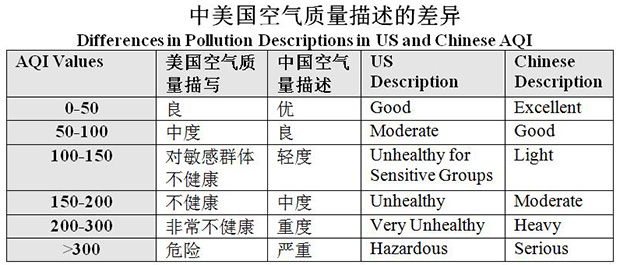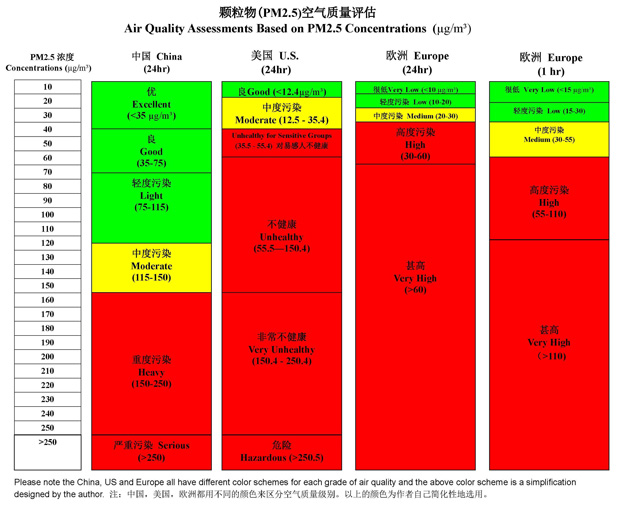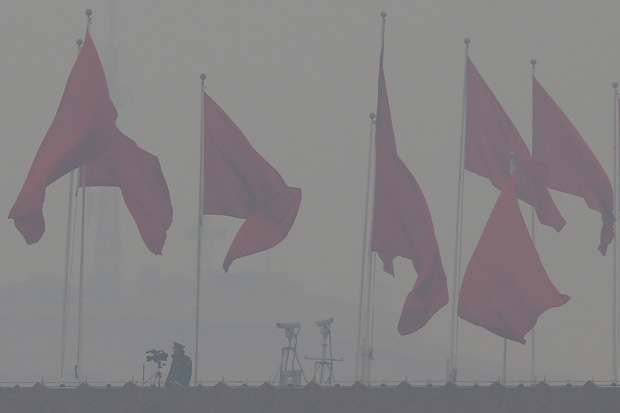China’s air pollution is being reported in a misleading way, blocking public understanding and enabling official inaction. Outdoor air pollution in China causes an estimated 1.2 million premature deaths and 25 million healthy years of life lost annually. Experts estimate that living in a highly polluted Chinese city results in a three-year reduction in life expectancy (compared with living in a very clean city, such as Tuscon, Arizona), or approximately twelve days per one-year exposure. Living in a moderately polluted Chinese city results in a reduction in life expectancy of 1.6 years, or approximately six days per one-year exposure. Shockingly, all seventy-four Chinese cities ranked in 2013 had annual pollution levels worse than moderately polluted and over sixty-six percent were worse than highly polluted.
Yet, based on the qualitative assessment scale in the Ambient Air Quality Index Technical Regulations, these same “moderately polluted” cities can officially report up to 365 days of “excellent or good” air quality. Even in Beijing, where fine particulate concentrations are nearly double those of a “highly polluted city,” on average only one day a week has worse than “moderate” pollution. People in China desperately want to know the possible adverse health effects of air pollution and when they should take action to avoid exposure—such as wearing a pollution mask.
But even though there has been a proliferation of mobile apps and websites providing air quality information—three apps have been downloaded over a million times—there is still substantial confusion over what these and other air quality assessments mean. This figure shows the great discrepancies in how the same AQI values are described by U.S. and Chinese reporting systems.

Pollution levels that the World Health Organization considers to be a “significant concern” and for which “immediate actions” are recommended” are described as “good” air quality in China. Therefore, it is not surprising that on days when the U.S. Embassy reports “very unhealthy” pollution, the Chinese assessments are “moderate”—even when reported daily concentrations are similar. Or, that hourly concentration of airborne fine particulate matter (PM2.5) considered “medium” in Europe are classified as “excellent” if at those high levels for a day in China. But, according to China’s Ministry of Environmental Protection it is “obviously inappropriate” to report China’s air quality based on foreign standards. This figure shows the different ways that the same PM 2.5 concentrations are classified according to their health impacts (see a larger version of this graphic).

While many mobile apps and websites report pollution levels from the U.S. Embassy and Chinese monitors based on hourly concentrations and the U.S. index system and assessments, others use the Chinese index and assessments, or a mix of the two, such as reporting air quality based on the U.S. index and Chinese assessments. One of the most popular apps mistakenly equates the Chinese assessments as the same as the English, i.e. the English version uses the U.S. Environmental Protection Agency’s assessments while the Chinese version uses the Chinese assessments even though they are very different. No wonder the public is confused.
Officially, Beijing had 307 days in 2013 where air pollution was at moderate levels or better. But Beijing’s annual fine particulate concentration of 90.1 micrograms per cubic meter (and approximately 103 micrograms at the U.S. Embassy) was over nine times the WHO guidelines—even on days when pollution is fifteen times the WHO annual guidelines the government classifies the air quality as “moderate.” Twelve cities were worse than Beijing, including Xingtai in Hebei province, which had an annual concentration of 155 micrograms per cubic meter.
In other countries “light pollution” on a daily basis generally means levels of pollution below an annual standard, but in China “light” pollution includes pollution over three times China’s annual standard and eleven times the WHO annual guideline.
Unfortunately, China’s qualitative assessments of pollution levels have not been fixed since public reporting began in 1997, and in Beijing at least, public reporting of annual pollutant concentrations is worse than it was fifteen years ago. Previously, Beijing reported annual average concentrations for individual monitoring stations but that has not been done since 1998. China’s National Ambient Air Quality Standards may be reasonable for China’s current level of development, even if much higher than levels the World Health Organization considers safe. But public reporting should be based on the impacts to human health, not a legal standard.
What do AQIs Actually Measure?
Air Quality Indices (AQI) were designed to promote greater public understanding of pollution levels and their impacts on health, but differences in methods of measurement and reporting have led to public confusion. Due to a proliferation of different indices, the U.S. Environmental Protection Agency developed a national air pollution index system in 1976. China adopted a similar index when public reporting began in 1997, although the assessments of index values were and remain very different. For example, levels classified as “unhealthful” in the U.S. were called “light pollution” in China.
The AQI gives a value from one to 500, along with a qualitative assessment of the air quality and cautionary statement regarding health impacts. The AQI incorporates into a single index concentrations of five pollutants: particulate matter (PM2.5 and PM10), ozone (O3), carbon monoxide (CO), sulfur dioxide (SO2), and nitrogen dioxide (NO2) measured over different time periods. The AQI is equal to the highest of the numbers corresponding to each pollutant. According to both the U.S. and Chinese governments, when the AQI reaches unhealthy levels (AQI 150) everyone should reduce outdoor activities, and at hazardous levels (AQI 300) everyone should avoid all outdoor activities. Since 2008, the U.S. Embassy in Beijing has tweeted both hourly and daily particulate concentrations together with health-based assessments of air quality. U.S. Consulates in Shanghai, Chengdu, and Guangzhou have also begun reporting.
In the U.S., for PM2.5 the annual level is the main basis for protecting against short term concentrations. Therefore, when PM2.5 began being reported in 1999, while a level of fifty was set at the annual health-based standard of fifteen micrograms per cubic meter—the level determined safe to breathe long-term—150 or the cut-off for “unhealthy” air was set at the then daily standard of sixty-five micrograms per cubic meter.
For intermediate breakpoints in the AQI between values of 150 and 500, PM2.5 concentrations generally reflect a linear relationship between increasing index values and increasing PM2.5 values. An AQI of 500, the “Significant Harm Level,” was tentatively set at 500 micrograms per cubic meter and has not been revised. Meanwhile, in China an AQI of 100 for PM2.5 was set at the daily standard of seventy-five micrograms per cubic meter. PM2.5 is the primary pollutant of concern in China, although rising nitrogen dioxide concentrations (not measured by the U.S. Embassy) and high ozone are also causes for concern.
The regularity of “hazardous” pollution has outraged the Chinese public and prompted the Chinese government to revise its monitoring and reporting system. But there have also been complaints—including from the Chinese government—that the U.S. Embassy monitoring from a single location is not representative of the city and that hourly pollutant concentrations should not be compared to a daily standards.
The Need for Hourly Reporting
Although reporting of concentrations by the U.S. Embassy and China is done based on both daily and hourly average concentrations, the U.S. Embassy includes an assessment and AQI based on the preceding hour average concentrations with a notice saying “if at this level for 24 hours.” Because the U.S. and Chinese particulate standards and AQI are based on twenty-four-hour concentrations, the Chinese government and others have criticized the U.S. Embassy for reporting an AQI based on a single hour average. The Chinese AQI for particulate is based on a moving twenty-four-hour average.
But in the U.S. hourly readings are still important—the U.S. Environmental Protection Agency uses hourly monitored readings from across the U.S. and displays them in terms of the AQI on the AirNow website. Although AirNow uses multiple hourly readings to calculate an AQI, the most recent single hour is heavily weighted in determining the reported AQI. On the AirNow website, the most recent hour effectively accounts for fifty percent of the averaged value, the second most recent twenty-five percent, the third 12.5 percent, etc.
The U.S. Embassy method of reporting an AQI value for the most recent hour also avoids over-reporting the severity of pollution when the wind comes up and blows away the smog. If the air quality improves significantly, the public can quickly know that it is safe to go outside.
In the U.S., there is no hourly standard largely because the primary annual fine particle standard is designed to protect against health effects associated with both long- and short-term exposure to PM2.5. Controlling annual concentration levels to low levels effectively eliminates spikes in daily and hourly concentrations.
The U.S. recently lowered the annual standard for PM2.5 to twelve micrograms per cubic meter. Beijing’s annual average PM2.5 concentration in 2013 of 103 micrograms per cubic meter, as measured by the U.S. Embassy, was approximately 8.5 times higher than the U.S. standard (and other parts of Beijing had even higher particulate levels). The recently revised standards in the U.S. also recognized the importance of near roadway monitoring, because “a significant fraction of the population lives in proximity to major roads, and these exposures occur in locations that represent ambient air.” This is consistent with EPA’s original 1976 guidance that stated: “in order to err on the side of public safety, the index stresses reporting on the basis of the stations with the highest pollutant concentrations and assumes that other unsampled areas will also experience high concentrations.”
In Europe, which does assess air quality based on hourly average fine particulate concentrations and does monitor near roadways, particulate concentrations at less than half of what are called “hazardous” in the U.S. and Chinese AQI are still classified as the most serious “very high” level of pollution. Washington and Montana in the U.S. also developed an hourly reporting system for particulate and determined that a single hourly average concentration at over 340 micrograms per cubic meter should be considered hazardous, and anything over 200 micrograms per cubic meter should be considered “very unhealthy.” Washington State believed that the U.S. AQI did not accurately show health impacts from air pollution and determined that the daily average cutoff for hazardous pollution should be set at approximately 135 micrograms per cubic meter. EPA scientists had proposed to lower the “hazardous” standard in the U.S. but were stopped by the Department of Agriculture.
Near real-time assessments of the air quality and the health impacts provided by the U.S. Embassy and Consulates are critical for helping the public to limit their exposure during the regular occurrences of high pollution levels. There is an urgent need to revise the deceptive assessments of air pollution devised fifteen years ago and to re-start reporting of annual monitoring station data.




